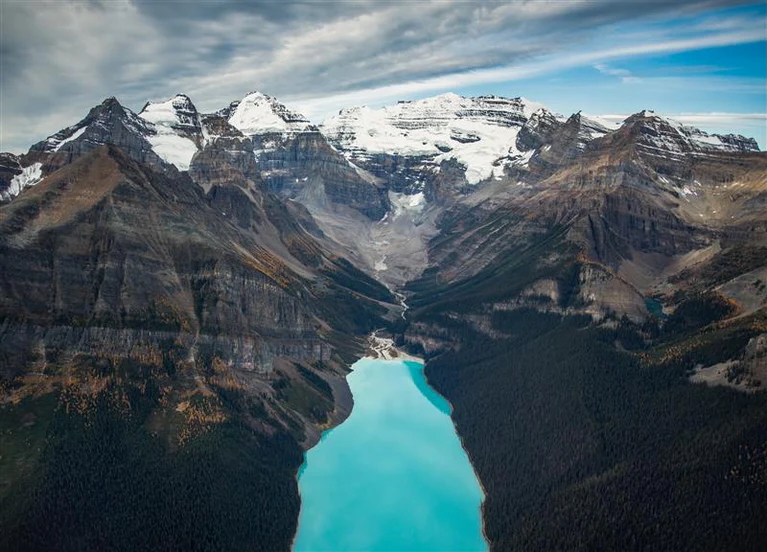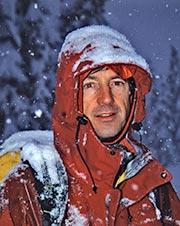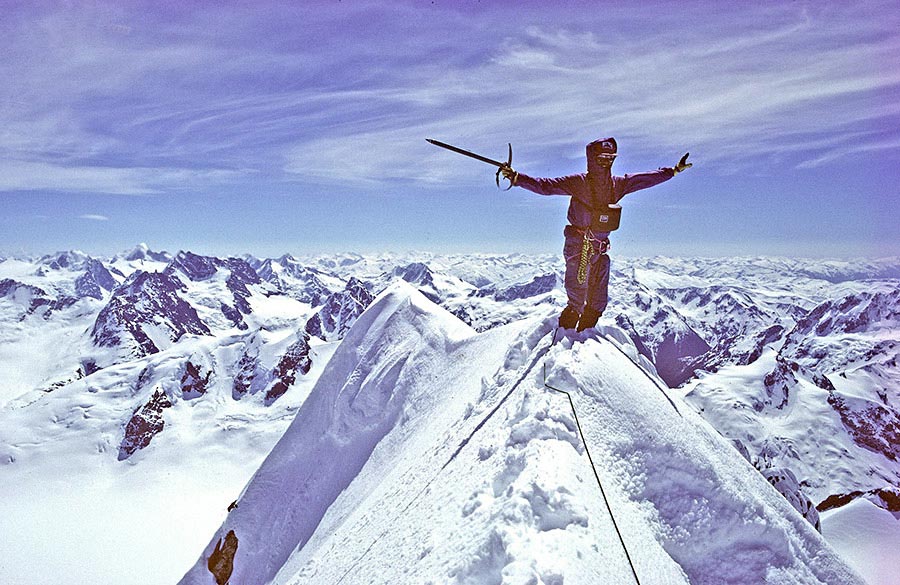Capturing the mountain experience
Aloft: Canadian Rockies Aerial Photography
by Paul Zizka
Victoria: Rocky Mountain Books, 2021
$35 / 9781771606929
Mountains of the Coast: Photographs of remote corners of the Coast Mountains
by John Baldwin
Madeira Park: Harbour Publishing, 1999
$36.95 / 9781550172133
Reviewed by Ron Dart
*

There are photographic books on the Canadian Rockies worthy of a few scans and there are superb books on the Canadian Rockies—such is Aloft. The title and subtitle offer the curious the visual nature of this bounty of a book. The photographs are, indeed, taken from above the Rockies and the photographer is very much aloft, the introduction by photographer Paul Zizka worthy of a reflective read (as are his visual gifts).
The photographs taken reflect all the seasons in the Canadian Rockies and track the varied faces and forms of the Rockies in a sort of ordered journey, Rundle Range and Three Sisters near Canmore taking the lead and initial bow, Mount Assiniboine area stepping on stage to strut its sheer beauty. Then, it’s to Banff, Lake Minnewanka, Sulphur Mountain, Mount Louis and Mount Norquay ski hill bounties not to miss. The photographic journey turns northward to Castle Mountain, Sunshine Meadows (summer and winter on display), Bourgeau Lake, Shadow Lake, Storm Mountain and Shadow Lake Lodge next on the Rocky Mountain and Taylor Lake aloft tour. It was inevitable, of course, on the photographic overview of the Rockies that Lake Louise and Moraine Lake would be next to visit, their expansive and epic like grandeur worthy of multiple meditative moments. Those who have lingered and trekked in the area are amply rewarded by photographs of Eiffel Lake, Sentinel Pass, Lake Agnes (tea hut ever present), Temple, Victoria-Lefroy and Louise Ski Hill, of course. Lake Louise freezes in the winter and the shoveled Lake near Chateau is cleared and turned into rinks to skate on (many pleasant memories of skating on Louise in winter).

Zizka has eloquently captured the golden beauty of the alpine larches in the early autumn. The photographic pilgrimage continues into British Columbia to the ever charming Lake O’Hara region with its rich and layered history, Yoho, many trails done there and Takakkaw Falls a place not to miss (many a night spent sleeping at the base of it). The turn is then made, ever aloft, to Kootenay National Park, the Icefields Parkway the journey ever northward from an aerial perspective, Bow Lake highlighted (treks taken from there worth the doing as is kayaking on the lake), Peyto Lake front-and-centre (the starting point for the Wapta Traverse).
The aerial overview maintains a northwards flight, Saskatchewan and Athabasca Glaciers illuminated, crevasses noted and Mount Athabasca (climb worth the effort) duly noted, tourist trips part of the photographic package. Jasper National Park, rightly so, comes into attractive and compelling hue. Fortress Lake, Hooker Icefield and Chisel Peak are but tasters and teasers. But the images of Jasper and Edith Cavell, Fairmont, Chevron and Ramparts, Tonquin Valley, and Amethyst Lakes are remarkable photographs not to miss (nor, in the Rockies, treks not to miss). Humber Provincial Park is given its prominent places as is Mount Alberta and the ever-attractive Maligne Lake, Mt. Robson, and Berg Lake next on the agenda as Jasper is left behind.

There is much more that could be said about this photographic and aerial overview of the Canadian Rockies, but for those who have done many of the trips in the area, skated, skied, trekked, hiked, and climbed many of the peaks, Aloft is a memory-massager and reminder of the vast, compelling, immense, and perennial appeal of the Canadian Rockies.

*

Roughly three times the size of the Sierra Nevada or the European Alps, the Coast Mountains see fewer climbers in an entire year than the Alps or Sierra do in a busy weekend. Few mountain regions, except Antarctica and the far north, can offer the same degree of pristine wilderness as the Coast Mountains.
-John Baldwin, Mountains of the Coast
I have, for many years, been taken by mountaineers who are also exquisite photographers. A year ago, I spent an afternoon at Galen Rowell’s studio in Bishop, California (Rowell was one of the finest mountain photographers in the USA until his untimely airplane death in 2002). Pat Morrow is one the most artistic mountain photographers in Canada. Morrow is, in many ways, the Rowell of Canada. John Baldwin is the Rowell and Morrow of the B.C. Coast Range, and his Mountains of the Coast is ample proof of why this is the case.

Mountains of the Coast is textually lean, evocative, and alluring and replete with some of the most graphic and superb photos that tell the tale so well of Baldwin’s many trips (often with John Clarke—who appears in many photos) in the Coast Mountains. Mount Waddington factors large in many of the well-wrought and time-tried photographs. It is quite easy to read the book in a single sitting. Needless to say, each reread and visual journey through the text leads the reader into an oft unknown part of B.C.. The missive is divided into four sections: Introduction, On Foot, On Skis, and Into the Silence. Each of the trips described in the text, whether by foot or ski, are generously illuminated by artistic prints from mountains, glaciers, inlets, alpine flora, and fauna and the occasional icons of the white spires: mountain goats. There is a definite drama at work in Mountains of the Coast that draws the reader into the mountain tale being told. Baldwin and friends have taken the patient time to ski and hike, from Bella Coola in the north, across many a snow packed and glacier highway, on a variety of well-planned trips through all sorts of weather conditions, to Vancouver in the south—rare are those who have done what Baldwin has done in the Coast Mountains, and Mountains of the Coast unfolds, in poignant detail, the highlights of such trips.
Mountains of the Coast is unique in its genre. The book had been in print for more than two decades [currently out of print], but there is no book that can equal or surpass the beauty and brilliance of these psalms of praise to the expansive cathedral of the coastal mountains of British Columiba—the trips told and the photographs used are threaded together so well the reader almost feels like he or she is on skis, hiking the white towers or being picked up by float planes or helicopters with Baldwin. Mountains of the Coast should be in the library of all mountaineers, photographers, and aficionados of the vast and mostly untouched and untamed mountain range of coastal B.C..

Piz Gloria
Ron Dart
*

Ron Dart has taught in the Department of Political Science, Philosophy, and Religious Studies at the University of the Fraser Valley since 1990. He was on staff with Amnesty International in the 1980s. He has published 40 books including Erasmus: Wild Bird (Create Space, 2017) and The North American High Tory Tradition (American Anglican Press, 2016). [Editor’s note: Ron Dart has recently reviewed books by Diane Kalen-Sukra, Stanley Munn & Patricia Cucman, Don Munday, Susan Leslie, Torbjørn Ekelund, Jan Zwicky, and Jan Zwicky & Robert V. Moody, for The British Columbia Review. He has also contributed four essays: Canadian mountain culture and mountaineering, From Jalna to Timber Baron: Reflections on the life of H.R. MacMillan, Roderick Haig-Brown & Al Purdy, and Save Swiss Edelweiss Village.]
*
The British Columbia Review
Interim Editors, 2023-25: Trevor Marc Hughes (non-fiction), Brett Josef Grubisic (fiction)
Publisher: Richard Mackie
Formerly The Ormsby Review, The British Columbia Review is an on-line book review and journal service for BC writers and readers. The Advisory Board now consists of Jean Barman, Wade Davis, Robin Fisher, Barry Gough, Hugh Johnston, Kathy Mezei, Patricia Roy, and Graeme Wynn. Provincial Government Patron (since September 2018): Creative BC. Honorary Patron: Yosef Wosk. Scholarly Patron: SFU Graduate Liberal Studies. The British Columbia Review was founded in 2016 by Richard Mackie and Alan Twigg.
“Only connect.” – E.M. Forster
2 comments on “Capturing the mountain experience”